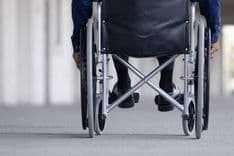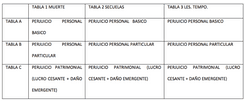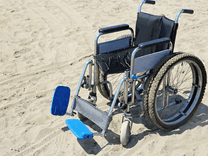One of the most common injuries after a car accident is the whiplash trauma or injury, it is that common that it costs insurers millions of euros a year in compensation. So if you want to claim compensation for whiplash caused by a car accident, here is everything you need to know about this type of injury, the scale and how to present your claim to the insurance company.
What is whiplash trauma?
A cervical sprain or whiplash is an injury that occurs as a result of an energetic and rapid flexion and extension movement of the neck, from back to front, which causes a tear in the bony tissue and soft tissue that joins the cervical vertebrae.
This abrupt hyperextension of the neck usually follows an unexpected impact in which the energy of the blow is transferred to the neck and, because the muscles are relaxed, cannot react in time to limit the range of motion.
Types or degrees of neck sprain or whiplash
The symptoms that appear after suffering whiplash are what indicate what type of whiplash injury you may have. Therefore, you should know that there are three types or grades of whiplash.
Grade or Type I sprain
This is the most superficial sprain in the classification and is sometimes difficult to detect. In this type of injury, the stretching of the tissues of the neck is small, without rupture, and therefore the resulting sprain is mild.
Although there are no physical signs of injury in this grade, you may feel pain in the nape, neck, head or upper limbs (neck pain or cervicalgia) and/or stiffness and reduced mobility of the neck.
Cervical sprain Grade or Type II
In this type of sprain, the contracture that occurs is more significant, as there is a moderate elongation of the muscles and ligaments. In some cases, there is partial rupture of the tissues, although they do not separate, and this can limit the movement of the joint. In this case we are talking about a grade 2b cervical sprain.
In injuries of this type, you may feel pain on palpation and even have considerable swelling. In addition, there may be a rectification of the normal curvature of the cervical area.
Grade or Type III cervical sprain
In this grade of sprain there are already signs of neurological injury. The tissues of the neck have ruptured and separated as a result of extreme stretching or elongation. The movement of the neck is totally limited, given the intensity of the contracture, and in most cases the use of a neck brace is necessary.
In this case, the pain on palpation of the area is very acute and symptoms of neurological involvement appear, such as tingling, lack of strength in the limbs, numbness or loss of reflexes, among others.
Most frequent symptoms of cervical sprains
The most common symptoms that occur immediately or shortly after whiplash are:
- Severe pain in the neck and shoulders (cervicalgia).
- Stiffness and pain when moving the neck.
- Muscle contracture.
- Headaches or cephalea.
- Dizziness, vertigo or blurred vision.
- Confusion and disorientation
- Tingling and numbness in arms or legs.
- Sensitivity to noise.
- Insomnia, anxiety and difficulty concentrating.
- Tiredness or weakness.
Compensation according to the accident scale for cervical whiplash
When you suffer a cervical sprain, or whiplash, the compensation is calculated according to a scale that takes into account the type of injury suffered and its after-effects. In this document, this type of injury is considered "minor trauma to the spine".
Compensation for whiplash, according to the scale, is made up of several sections or items:
- The main one is the item for temporary injuries or health days. This corresponds to the period between the date of the accident and the last day of rehabilitation, not the day of discharge. During this period, moreover, the days are compensated differently:
- Days of very serious injury, in case of admission to the ICU.
- Days of serious injury. If there is hospital admission.
- Days of moderate injury. When there is an incapacity to carry out daily activities.
- Days of basic injury. Those in which you can carry out your normal activity, but rehabilitation has not yet been completed.
- The amount for the physical, intellectual, aesthetic and sensory sequelae that persist once the rehabilitation period has ended, after discharge. This amount will have to be determined by a medical expert in damage assessment.
- The item for patrimonial loss, i.e., for the healthcare expenses incurred (consequential damage) and for the loss of earnings or income lost during the period of healing of the injuries.
How to claim compensation for whiplash: 72 hours to go to the doctor
If you have suffered whiplash, there are a number of steps to follow if you do not want to be left without compensation.
First of all, it is very important that you go to the hospital as soon as possible, within 72 hours after the accident, otherwise the insurer may say that the injury is not a consequence of the accident. So make sure you go to the doctor and keep all the documents they give you.
The next step is to report the claim to your insurer, you have one week to do so. Subsequently, they will call you to evaluate the material and physical damage of the accident, and they will indicate that you have to go to a specialist doctor. After this procedure, the insurer will make you a proposal of compensation with which you can agree or disagree.
The article of the schedule dealing with compensation for whiplash injuries
The section of the Law on Civil Liability and Insurance in the Circulation of Motor Vehicles that specifically affects victims of accidents with cervical sprain is article 135, which deals with "compensation for minor spinal injuries".
This article establishes four criteria to determine whether or not there is an entitlement to compensation:
- Exclusion. That there is no other circumstance that justifies the injury.
- Chronological. That the symptoms of the injury manifest themselves during the 72 hours following the accident.
- Topographical. There must be a relationship between the affected area of the body and the injury that justifies the pain.
- Intensity. That the hit to the vehicle is of sufficient severity to cause the injury.
Hence the importance of going to hospital as soon as possible, even if the discomfort is minor.
How much will compensation be paid for whiplash?
As we have already mentioned, compensation for whiplash is made up of several items. Therefore, the amount of compensation will vary depending on the type or degree of whiplash suffered, as this will influence the days of healing required, the recovery costs incurred and days off work, as well as the possible after-effects that may remain.
So in general, the compensation for whiplash can range between:
- Grade or type I sprain: 1.500- 3.000 €.
- Grade or type II sprain: €3,000- €6,000.
- Grade or type III sprain: €6,000-€10,000, depending on the evolution of the injury.













